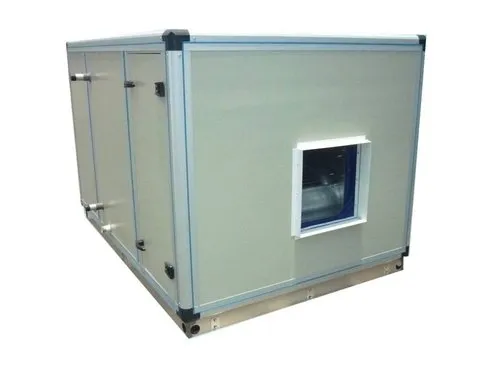Air Handling System
Home / Products / Air Handling Units (AHU) Manufacturer In India / Air Handling System
Air Handling System Manufacturer
An air handling system (AHS) is a critical component of heating, ventilation, and air conditioning (HVAC) systems in buildings. It is responsible for circulating and conditioning air within the building to maintain indoor air quality, temperature, and humidity levels. Here’s an overview of its function and construction:
Function of Air Handling System
- Air Circulation: The primary function of an air handling system is to circulate air throughout the building. It draws in outside air and recirculates indoor air, distributing it to various spaces through a network of ducts and vents.
- Air Filtration: AHS typically includes filters that capture airborne particles such as dust, pollen, and allergens, improving indoor air quality by removing contaminants.
- Temperature Control: The air handling system controls the temperature of the air circulated throughout the building. In heating mode, it warms cold air using a heat exchanger or heating coil, while in cooling mode, it chills warm air using a refrigeration system.
- Humidity Control: AHS helps to regulate humidity levels within the building by adding moisture to the air when it's too dry or removing excess moisture when it's too humid. This ensures a comfortable and healthy indoor environment.
- Ventilation: The air handling system provides ventilation by bringing in fresh outside air and exhausting stale indoor air. This helps to replenish oxygen levels, remove indoor pollutants, and maintain proper air exchange rates for occupant health and comfort.

Air Handling System
Construction of Air Handling System
- Fan: The heart of the air handling system is the fan, which draws air into the system and circulates it throughout the building. The fan may be located in the main air handling unit or in individual units serving different zones of the building.
- Air Filters: Air filters are essential components of the AHS that remove airborne particles and pollutants from the air. They come in various types, including mechanical filters (e.g., fiberglass, pleated), electrostatic filters, and HEPA filters, each offering different levels of filtration efficiency.
- Heat Exchanger or Heating Coil: In heating mode, the air handling system uses a heat exchanger or heating coil to warm cold outside air before distributing it into the building. This ensures that the air entering the building is at a comfortable temperature.
- Cooling Coil: In cooling mode, the air handling system uses a cooling coil or refrigeration system to chill warm indoor air before circulating it back into the building. This helps to maintain a cool and comfortable indoor environment during hot weather.
- Humidifier and Dehumidifier: Some air handling systems are equipped with humidifiers and dehumidifiers to regulate indoor humidity levels. Humidifiers add moisture to dry air, while dehumidifiers remove excess moisture from humid air, ensuring optimal humidity levels for occupant comfort and health.
- Ductwork: A network of ducts distributes conditioned air from the air handling unit to various spaces within the building and returns stale air back to the unit for reconditioning. Dampers and valves may be installed in the ductwork to regulate airflow and control temperature and humidity levels in different zones.
Applications of Air Handling System
Air handling systems have a wide range of applications in various types of buildings and facilities, where they are essential for maintaining indoor air quality, comfort, and safety. Here are some common applications:
- Commercial Buildings: Air handling systems are extensively used in offices, retail stores, restaurants, and other commercial establishments to provide heating, cooling, ventilation, and air filtration. These systems help create a comfortable and healthy indoor environment for occupants, improving productivity, customer satisfaction, and overall business operations.
- Residential Buildings: In residential settings such as single-family homes, apartments, and condominiums, air handling systems, often integrated with HVAC systems, provide heating, cooling, and ventilation. They help regulate indoor temperature and humidity levels, remove indoor pollutants, and ensure a comfortable living environment for residents.
- Healthcare Facilities: Air handling systems are critical in hospitals, clinics, nursing homes, and other healthcare facilities, where maintaining clean and sterile indoor environments is essential for patient health and safety. These systems help control airborne contaminants, prevent the spread of infections, and provide specialized ventilation for areas such as operating rooms, isolation rooms, and cleanrooms.
- Laboratories and Research Facilities: Laboratories, research facilities, and pharmaceutical manufacturing plants require precise control over indoor air quality and environmental conditions to protect sensitive experiments, equipment, and products. Air handling systems provide specialized ventilation, filtration, and humidity control to maintain clean and controlled laboratory environments.
- Educational Institutions: Schools, colleges, and universities rely on air handling systems to create conducive learning environments for students and teachers. These systems help regulate indoor temperature and humidity levels, provide adequate ventilation, and remove indoor pollutants, contributing to improved indoor air quality and student well-being.
- Industrial Facilities: Air handling systems are used in various industrial settings, including manufacturing plants, warehouses, and cleanrooms, to provide ventilation, air filtration, and climate control. They help remove airborne contaminants, control indoor temperatures, and maintain optimal conditions for industrial processes, equipment, and worker safety.
- Data Centers: Data centers require precise temperature and humidity control to protect sensitive electronic equipment and ensure uninterrupted operation. Air handling systems provide cooling, humidity control, and air filtration to maintain optimal environmental conditions for data center equipment and prevent overheating or malfunctions.
- Commercial Kitchens: Air handling systems are employed in commercial kitchens and food service establishments to remove cooking odors, grease, and smoke, and to provide adequate ventilation for indoor air quality and fire safety.
